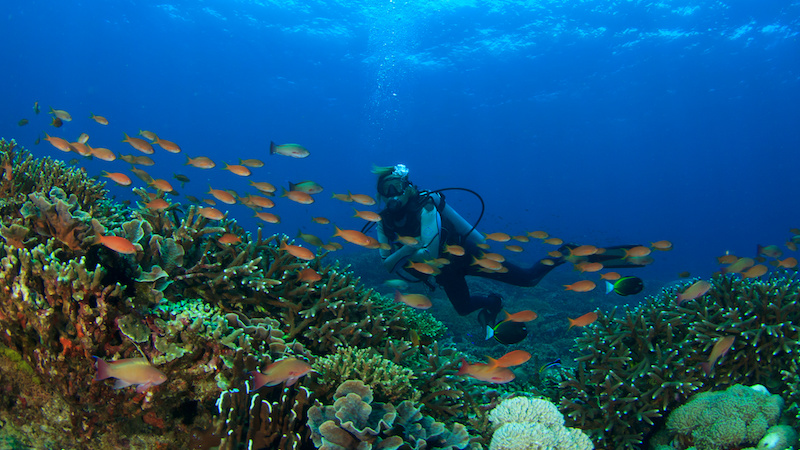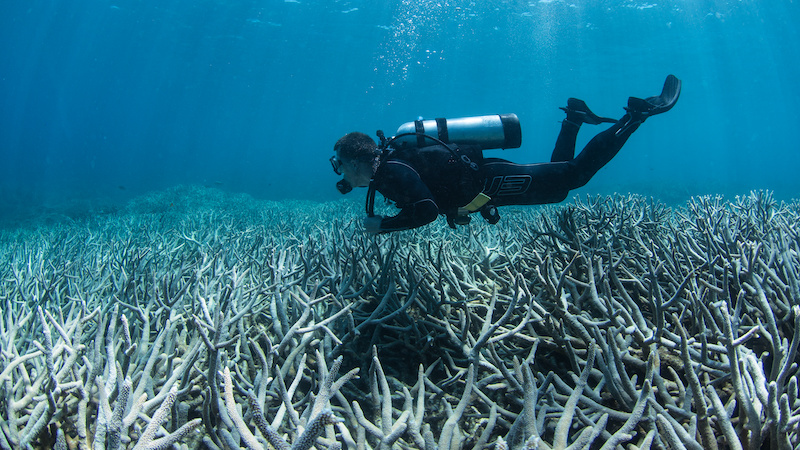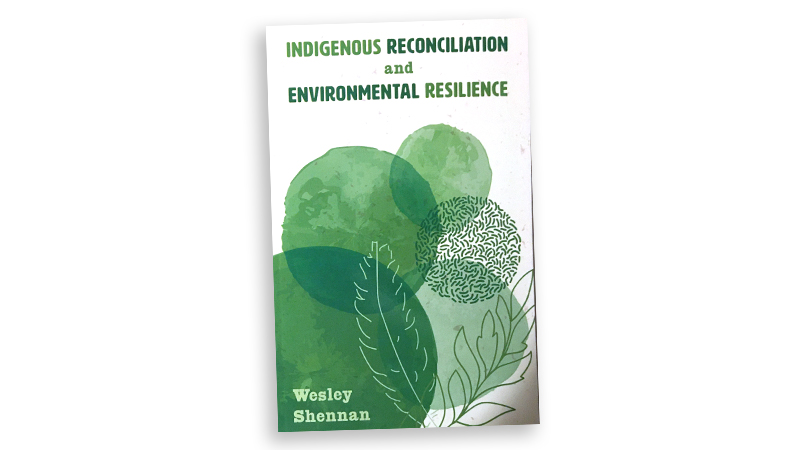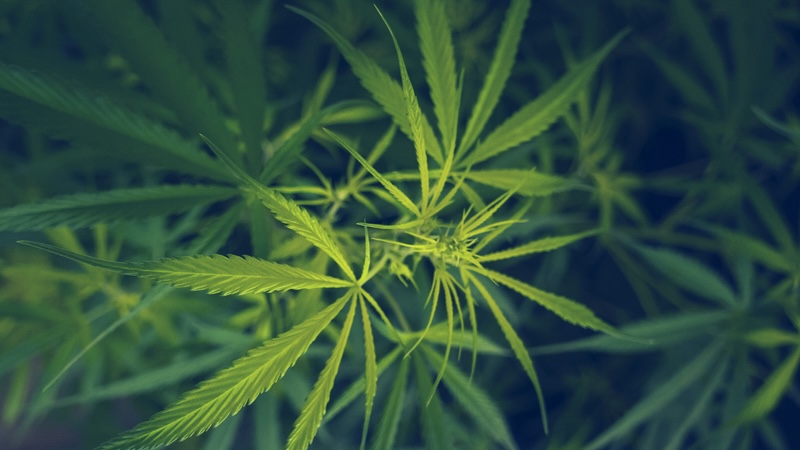Coral Reefs and Environmental Resilience
Abridged excerpt from ‘Indigenous Reconciliation and Environmental Resilience’ used with permission

Too bad the coral reefs are dying, but it really makes no difference to me.
This statement, or something similar, is typical of those who really don’t understand, or choose not to understand, the complicated interconnectedness of the natural environment, the plants, and the animals on this magnificent planet. The total disappearance of coral reefs will, most likely, result in the disappearance of millions of people on this earth!
The doubters will say I’m just being alarmist. I’m being an alarmist, I admit. But I’m being an alarmist because it really looks like the future of millions of humans – and countless ecosystems – on earth and in the ocean are coming to an end. And, coming to an end in the next 30 to 40 years! Why wouldn’t I be an alarmist?
A coral reef, simply defined, is a ridge of rock in the sea formed by the growth and deposit of coral. It’s an underwater ecosystem characterized by reef-building corals. Reefs are formed of colonies of coral polyps held together by calcium carbonate. Most coral reefs are built from stony corals, whose polyps cluster in groups. The nearest tropical coral reef to me is in the Sea of Cortez off the coast of the Baja Peninsula in Mexico—some 2,500 kilometres away. I’ve been fortunate to have once snorkelled in a warm-water coral reef off the island of Cozumel, Mexico in the Caribbean. Another person in the water took my picture while I was snorkeling and had to wave his hand to clear the brightly coloured tropical fish away from my face to get a clear shot. It was amazing to be surrounded by fish like those shown in the healthy reef photograph above, and especially astounding for an Albertan whose previous natural fish encounters amounted to an aggressive jackfish (northern pike) resembling a barracuda, and swimming in shallow, murky prairie lakes filled with green aquatic weeds and algae.
According to the online publication Reef Relief, coral reefs are one of the most biologically diverse ecosystems on earth, rivalled only by tropical rainforests. They’re made up of not only hard and soft corals, but also sponges, crustaceans, mollusks, fish, sea turtles, sharks, dolphins, and much, much more. The health, abundance, and diversity of the organisms that make up a coral reef are directly linked to the surrounding terrestrial and marine environments.
What are the facts?
According to the National Geographic and the National Oceanic and Atmospheric Administration (NOAA), there are about six thousand species of coral around the world, with some species growing in warm shallow waters near coastlines and others thriving on the dark, cold seafloor of the open ocean. Coral reefs are essential to healthy coasts and vibrant economies, playing a critical role in everything from protecting lives and real estate to supporting thousands of businesses. Within the United States alone, the total estimated value of coral reefs for fisheries, tourism, and coastal protection is more than $3.4 billion each year. And it’s estimated that coral reefs prevent $94 million in flood damages every year; the US ranks in the top-10 countries to receive risk-reduction benefits from coral reefs. Approximately 25% of all marine species are found in, on, and around coral reefs. Coral reefs, often referred to as the “rainforests of the sea,” are supporting wildlife, providing food, jobs, and coastal protection for an estimated 500 million people.
What’s happening to the coral reefs?

Bleaching. Prolonged anomalously warm ocean temperatures in just one year (2016) turned many of the coral reefs white, with heat stress affecting 51% of all coral reefs globally. Bleaching is usually, but not always, a sign of death. The first mass bleaching (85%) of Australia’s northern and far-northern Great Barrier Reef in 2016 killed 29% of the reef’s shallow-water corals. The same occurred to coral reefs in much of the western Indian Ocean (69 to 99% bleached) and the Seychelles (50% dead). From 2014 to 2017, heat stress brought mass bleaching to more than 75% of the world’s reefs; nearly 30% suffered mortality level stress. For more information, please see Dennis Brady’s articles in the Washington Post, 2019 and 2016.
Extrapolating global-warming information to its effect on coral reefs from 2017 to 2020 is frightening. A report presented at an ocean sciences conference by scientists from the University of Hawai’i at Manoa in 2020, estimated that about 70–90% of all existing coral reefs are expected to disappear in the next 20 years due to warming oceans, acidic water, and pollution. The researchers warned that climate change was the big killer—human pollution, while a problem, is only a small part of the larger threat.
Who’s affected?
In 2016, an international group of researchers mapped places where people most need reefs for their livelihoods, particularly for fishing and tourism, as well as for shoreline protection. This was combined with maps showing where coral reefs are under the most stress from warming and ocean acidification. Countries in Southeast Asia—such as Indonesia, Thailand, and Philippines—would bear the brunt of damage, as well as coastal communities in western Mexico, parts of Australia, Japan, and Saudi Arabia. The problem would affect countries as massive as China and as small as the tiny island nation of Nauru in the South Pacific. In many places, the loss of coral reefs would amount to an economic disaster, depriving fishers of their main source of income, forcing people to find more expensive forms of protein and undermining the tourism industry. In addition, many countries depend on coral reefs as a key barrier to guard against incoming storms and to mitigate damage caused by surging seas. Without healthy reefs, countries lose what is essentially a protective undersea wall. It’s been estimated that 62 million people live less than 10 metres above sea level and less than three kilometres from a coral reef! Waves coming into shore at full force, similar to a tsunami, cause loss of life and property. For more information, see Dennis Brady’s, Washington Post article, 2016; Coral Relief online publication, 2020; and Jessie Yeung’s, CNN Report, 2020.
In summary, the loss of coral reefs in the seas and oceans over the next 20 years negatively impacts 62 million people directly; over the next 40 years, this loss will severely and negatively impact at least 500 million humans. The main cause is global warming. Those who say this loss does not really affect them are either uninformed or delusional. The urgency needed to curtail global warming in accordance with the 2016 Paris Agreement at plus 2 degrees Celsius (ideally 1.5 degrees Celsius) becomes especially imperative when viewed from the perspective of coral-reef mortality.
Wesley Shennan, a member of the Michel First Nation, Treaty 6, in the area currently known as Alberta, Canada, is a community planner and has been working with First Nations in British Columbia for the past 22 years. His education in both the physical and social sciences, and work experience, has led him to share his understandings and encourage others to take action. He lives with his wife, Elena, in the now smoky and scorching hot Okanagan valley in southern British Columbia – the traditional unceded territory of the Syilx Nations. He is the author of “Indigenous Reconciliation and Environmental Resilience” (FriesenPress, July 24, 2022).
PHOTO CAPTION OF FEATURE IMAGE: Female scuba diver over a healthy coral reef, Licensed Adobe Stock Photography.
Also from Wesley Shennan:




